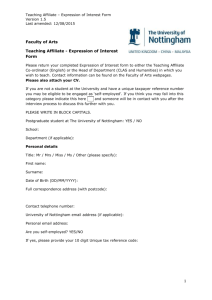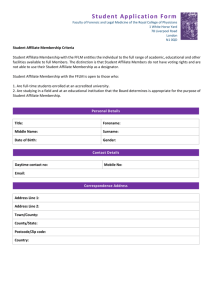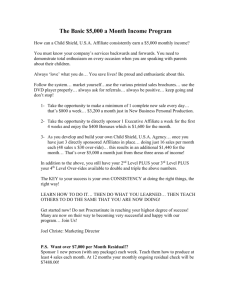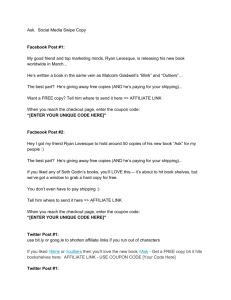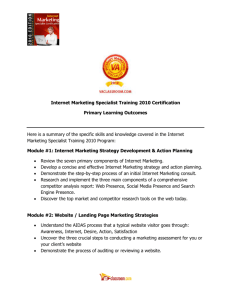Culture and Negotiation Strategy
advertisement
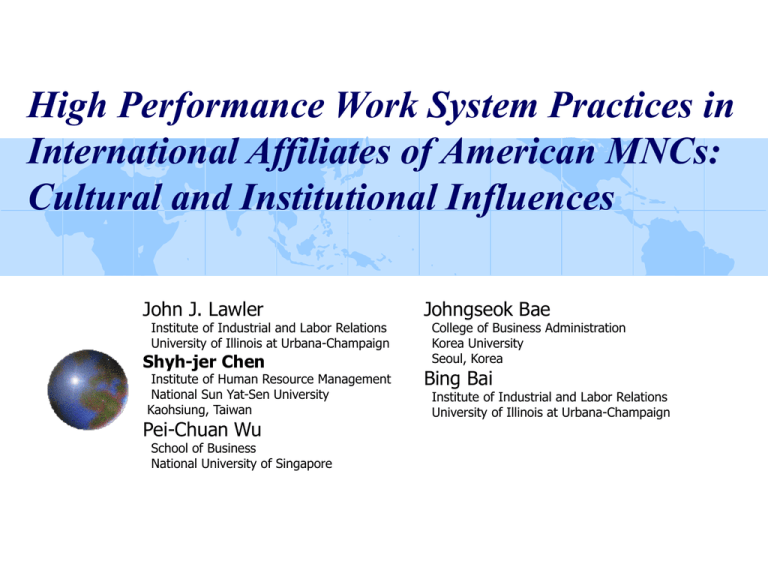
High Performance Work System Practices in International Affiliates of American MNCs: Cultural and Institutional Influences John J. Lawler Institute of Industrial and Labor Relations University of Illinois at Urbana-Champaign Shyh-jer Chen Institute of Human Resource Management National Sun Yat-Sen University Kaohsiung, Taiwan Pei-Chuan Wu School of Business National University of Singapore Johngseok Bae College of Business Administration Korea University Seoul, Korea Bing Bai Institute of Industrial and Labor Relations University of Illinois at Urbana-Champaign HR System and Firm Performance • Competitive advantage from internal resources--Jeffrey Pfeffer (1994; 1998) • Competitive advantage from external resources--Michael Porter (1980; 1985) • One best way conclusion from Jeffrey Pfeffer 2008/3/19 2 HR Practices and Firm Performance • Competitive Advantage from Michael Porter, 1980 • Several fundamental competitive forces that determine the ability of firms in an industry to earn above-normal returns:(產 業的競爭優勢決定於下列幾個因素) • the entry of new competitors(新競爭者的進入) • the threat of substitutes(替代品的威脅) • the bargaining power of buyers(買者的爭議力) • the bargaining power of suppliers(供應商的爭議力) • the rivalry among existing competitors(現有的對手) • product and process technology(產品的技術) 2008/3/19 3 HR practices and Firm Performance • Competitive Advantage through People, Jeffrey Pfeffer, 1994 • Five top-performing firms from 1972 to 1992 • Plenum Publishing (15,689%) • Circuit City (a video and appliance retailer; 16,410%) • Tyson Foods (a poultry producer; 18,118%) • Wal-mart (a discount chain; 19,807%) • Southwest Airline (21,775%) 2008/3/19 4 HR Practices and Firm Performance • Resource-based View (Barney, 1991) --Rare, non-substitutable, valuable, inimitable. --causal ambiguity: hard to understand the link between resource and competitiveness. --social complexity: culture, interpersonal relationship, company reputation. 2008/3/19 5 HR Practices and HR System • The content of HR practices • Theory-Driven • Data-Driven (Cluster analysis, Exploratory factor analysis) • HR practices—formative or reflective • HR architecture (Lepak & Snell, 1999) • Managerial vs. non-managerial • HR policy, practice, perception 2008/3/19 6 HR Strategies, Subsystems and Practices HR Strategies HR Subsytems HR Flow Work Systems Reward Systems Employee Influence 2008/3/19 HRM Practices Control-based Work System Recruitment & Low selectivity; Selection short-term needs; promotion from external Training & Limited training efforts Development Employment Little security Security Tasks & Clearly/narrowly defined jobs; Assignment same tasks for long time Teams & Job Little autonomy & Redesign responsibility Control Rules & Regulation Wage level Relatively low wages Performance& Ability-based Pay Performance Appraisal Employee Participation Employee Ownership Culture High Performance Work System High selectivity; long-term potential; promotion from within More extensive & general skills training High security Broadly defined jobs; Cross-utilization High autonomy & responsibility Values & Mission Relatively high wages Seniority-based pay; Unfair pay practices Ability/performance-based ; more fair practices Limited efforts; administrative purpose Very little involvement Extensive efforts; Developmental purpose High involvement Little ownership practices High ownership practices Separating people from each other; low trust & cooperation Symbolic egalitarianism; high 7 trust & cooperation HR System and Firm Performance • Measure of organizational performance • HR outcomes (turnover, absenteeism) • Organizational outcomes (productivity, quality, service) • Financial accounting outcomes (ROA, profitability) • Capital market outcomes (stock price, growth, returns) 2008/3/19 8 Study purpose This study examined the role of • intra-organizational force (business strategy, structural features) versus host-country institutional and cultural forces • Both above as determines of reliance on various dimensions of high performance work system (HPWS) utilization in international affiliates of S&P 500 companies. 2008/3/19 9 HR System and Firm Performance • American Context vs. International Context Huselid (1995) AMJ special issue in 1996 IJHRM • Convergence vs. Divergence Universalistic perspective Contingency perspective 2008/3/19 10 HRM practices of MNC affiliates Organizational factors Strategic factors •Country-of-origin effect •Company-of-origin effect Cultural factors Institutional factors Host-country effect Duality of International Firms • Global integration Economy of scale, serving global customers, competitive platforms, global branding • Local responsiveness Host government regulations, customer needs • Taylor et al. (1996) AMR Exportive, adaptive, integrative model 2008/3/19 12 4 Perspectives • • • • HR Strategy Perspective Cultural Perspective Institutional Perspective Organizational factors 2008/3/19 13 HR Strategy Perspective • Firms seek to achieve fit between organizational strategy and HR strategy. • A parent company will influence an international affiliate to pursue a HPWS approach at the local level will depend on the overall commitment of the parent company to such an approach and the degree to which the affiliate and parent company are highly integrated. • There are several arguments supporting this contemporary version of the convergence hypothesis (Rowley and Benson, 2002). 2008/3/19 14 Hypotheses-1/4 • 1a: HPWS practices will increase in an international affiliate to the extent that the parent company’s strategy stresses product differentiation. • Hypothesis 1b: HPWS practices will decrease in an international affiliate to the extent that the parent company’s strategy stresses cost leadership. • Hypothesis 1c: HPWS practices will increase in an international affiliate the greater the outflow of knowledge from the affiliate to the parent company. • Hypothesis 1d: HPWS practices will increase in an international affiliate the number of employees in the affiliate. • Hypothesis 1e: HPWS practices will increase in an international affiliate the greater the munificence of the external labor market. 2008/3/19 15 Cultural Perspective • Firms need transference to integrate HR policies and practices across international operations. Host country institutional and cultural environments are of only limited significance in shaping affiliate HR policies and practices. • Institutional theory is concerned environmental forces promote homogeneity among organizations. This is central to understanding tendencies of international affiliates to be like, or different than, indigenous companies (i.e., for HR systems to be more or less homogeneous). 2008/3/19 16 Hypotheses-2/4 • Hypothesis 2a: HPWS practices will decrease in an international affiliate the greater the value of Hofstede’s power distance scalefor the host country. • Hypothesis 2b: HPWS practices will increase in an international affiliate the greater the value of Hofstede’s individualism scale for the host country. • Hypothesis 2c: HPWS practices will decrease in an international affiliate the greater the value of Hofstede’s uncertainty avoidance scale for the host country. • Hypothesis 2d: HPWS practices will increase in an international affiliate the greater the value of Hofstede’s masculinity scale for the host country. 2008/3/19 17 Institutional Perspective • Much diversity in employment laws and regulations across countries reduce the ability of management at the affiliate level to implement changes and enforce policies consistent with HPWSs. • The strength of law and comprehensive societal institutions is highly relevant to a firm’s HRM practices. Firms are less concerned about incomplete legal issues in handling business matters and are less worried about labor-related problems, they are not so highly restricted by the local political/legal environment. 2008/3/19 18 Hypotheses-3/4 • Hypothesis 3a: The utilization of HPWS practices will decrease in an international affiliate the more restrictive host country labor legislation. • Hypothesis 3b: The utilization of HPWS practices will increase in an • international affiliate the greater the level of state efficiency. 2008/3/19 19 Organizational Factors • Training and the transmission of professional standards of conduct as a principal mechanism in the propagation of normative controls through organizations and groups of related organizations (Scott, 1995). • Much of the professional general management and HR training and education is rooted in the standard American curriculum. • Labor union involvement affects beliefs and norms within the affiliate. • Expatriate employees from the US parent company may serve as conduits for enhancing and expanding HPWS practices in the affiliate. 2008/3/19 20 Hypotheses-4/4 • Hypothesis 4a: The utilization of HPWS practices will increase in an international affiliate as the ratio of HR professionals to total employees in the affiliate increases. • Hypothesis 4b: The utilization of HPWS practices will decrease in an international affiliate as the percent of union members in the affiliate increases. • Hypothesis 4c: The utilization of HPWS practices will increase in an international affiliate as the percent of American expatriate employees in the affiliate increases. 2008/3/19 21 Research Methods- Sampling Procedures • Companies were randomly selected from the Directory of American Firms Operating in Foreign Countries (2003) • International subsidiaries of American MNCs. • Production and service (P&S) 100-500 companies • Six regions: East Asia (China, Korea, Japan, Taiwan), Southeast Asia (Thailand, Vietnam, Singapore), South Asia (India), Africa (South Africa, Kenya), Western Europe (Germany, Italy), and Eastern Europe (Russia). 2008/3/19 22 Research Methods- Data Collection • Two different questionnaires: 1. Company’s senior HR manager: focused on some general characteristics of the affiliate’s workforce and HR practices. 2. Senior business manager in the affiliate: dealt with such issues as parent company-affiliate relationships, affiliate organizational performance, organizational business strategy, and related issues. • The questions and date collection procedures were reviewed and approved by the University of Illinois Institutional Review Board. • A general protocol for data collection was developed for collaborators in each country, • Separate sections --2 groups of employees: middle and upper managers and production and service (P&S) workers-- dealing with training and development, staffing, compensation, and teamwork and empowerment. 2008/3/19 23 Table1 Number of Cases by Region and Host Country • Europe 25 Germany 9 • Southeast Asia 55 Italy 10 Southeast Asia Singapore 26 Russia 6 Southeast Asia Thailand 18 • East Asia 101 Southeast Asia Vietnam 11 China 18 • South Asia 18 Japan 12 India 18 Korea 43 • Africa 26 South Africa 26 Taiwan 28 • TOTAL 225 2008/3/19 24 2008/3/19 25 2008/3/19 26 Results Results Independent Variables Constant Staffing (Managers) 1.327 (2.594) Differentiation Strategy Cost Leadership Strategy Knowledge Outflow Number of Employees (log) Labor Market Munificence Age of Company Greenfield Site 0.080 (0.090) 2008/3/19 -0.065 (0.074) -0.017 (0.019) 0.635*** (0.126) -0.012 (0.043) -0.002 (0.004) 0.153 (0.160) Staffing (P&S) 6.961** (2.753) 0.128 (0.094) 0.006 (0.080) Compensation (Managers) -2.747 (2.691) Compensation (P&S) -2.846 (3.264) Training (Managers) -1.200 (2.676) 0.095 (0.093) 0.082 (0.091) 0.037 (0.108) -0.008 (0.076) -0.064 (0.091) -0.061 (0.077) -0.001 (0.020) 0.454** * (0.135) 0.042 (0.046) -0.006* (0.004) 0.303* (0.170) -0.002 (0.019) 0.041* (0.023) 0.013 (0.020) 0.734*** (0.130) 0.107 (0.158) 0.730*** (0.131) -0.096** (0.044) -0.004 (0.004) 0.002 (0.004) 0.051 (0.044) -0.119 (0.192) 0.003 (0.004) 0.060 (0.162) -0.027 (0.244) 0.147 (0.164) Training (P&S) 3.698 (2.725) 0.128 (0.094) -0.031 (0.079) Empowerment (P&S) 1.388 (2.655) 0.017 (0.020) 0.752*** (0.134) 0.037* (0.019) 0.027 (0.045) -0.007* (0.004) 0.182 (0.167) 0.130*** (0.044) 0.001 (0.004) 0.042 (0.091) -0.048 (0.077) -0.033 (0.130) -0.268 (0.163) 27 Joint Venture Industry: Computer Hardware and Software Industry: Banking and Finance Industry: Electronics Industry: Chemicals Industry: Industrial Manufacturing Industry: Consumer Products 2008/3/19 0.217 (0.204) 0.065 (0.217) -0.179 -0.117 (0.209) (0.219) 0.082 (0.207) 0.247 (0.251) 0.300 (0.211) 0.103 (0.215) 0.206 (0.211) 0.133 (0.214) -0.144 (0.210) 0.088 (0.208) 0.291 (0.316) 0.016 (0.266) -0.025 (0.279) 0.114 (0.270) 0.134 (0.241) -0.112 (0.284) -0.309 (0.278) 0.080 (0.271) -0.244 -0.372* (0.197) (0.210) 0.199 (0.254) 0.022 (0.266) -0.646* -0.407 (0.335) (0.352) -0.010 (0.203) 0.112 (0.300) 0.077 (0.400) -0.242 (0.342) -0.127 (0.302) -0.420** (0.205) -0.139 (0.265) -0.174 (0.350) 0.235 (0.200) 0.217 (0.257) -0.130 (0.201) 0.447* (0.263) 0.062 (0.348) 0.120 (0.259) -0.187 (0.276) -0.144 (0.256) -0.008 (0.053) 0.463* (0.262) 0.046 (0.267) 0.361 (0.260) 0.052 (0.208) 0.126 (0.258) 0.471 (0.341) 28 Power Distance -0.043** (0.019) Individualism 0.011 (0.008) -0.006 (0.009) Masculinity -0.020*** -0.016** (0.006) (0.006) Uncertainty -0.009 (0.009) -0.031*** Avoidance (0.009) Difficulty of 0.024*** 0.022*** Hiring (0.006) (0.006) Rigidity of Hours 0.013* (0.007) 0.017** (0.007) Rigidity of -0.045*** -0.054*** Employment (0.013) (0.014) State Efficiency -0.057 (0.047) -0.145*** (0.050) Union Density -0.007*** -0.008*** (0.002) (0.003) HR Professionals 10.510*** 7.799** per Affiliate (3.131) (3.695) Employee Expatriates per -1.016 (0.751) -0.362 Affiliate (0.791) Employee F-Ratio 4.006*** 2.901*** AdjusteR² 0.259 0.183 2008/3/19 0.002 (0.018) 0.016 (0.019) 0.010 (0.023) 0.026*** (0.009) -0.004 (0.010) -0.014** (0.006) 0.000 (0.007) 0.005 (0.009) 0.005 (0.011) 0.025*** (0.006) -0.004 (0.007) 0.016** (0.007) 0.000 (0.009) -0.040*** (0.014) 0.015 (0.016) -0.003 (0.019) -0.032* (0.019) -0.001 (0.009) -0.002 (0.009) -0.010 (0.006) -0.014** (0.006) -0.019** -0.027*** (0.009) (0.009) 0.004 (0.006) 0.011* (0.006) 0.013* (0.007) 0.011 (0.007) -0.008 (0.014) -0.033** (0.014) -0.001 (0.003) -0.005** (0.003) -0.039 (0.049) -0.088* (0.050) 8.552** 10.031*** (3.267) (3.697) -0.039** (0.018) -0.024*** (0.009) 0.022*** (0.006) -0.011 (0.009) -0.036*** (0.006) -0.001 (0.007) 0.033** (0.014) 0.044 (0.049) 0.048 (0.059) -0.002 (0.003) -0.005* (0.002) -0.004 (0.003) 10.026*** (3.177) 1.503 (4.174) 0.302 (0.760) 0.066 (0.892) 0.735 (0.779) 0.474 (0.788) -0.057 (0.768) 4.085*** 0.264 0.724 -0.035 3.191*** 0.201 3.015*** 0.190 3.583*** 0.231 -0.060 (0.049) 6.546* (3.602) 29 Summary of Findings Hypotheses Staffing (Managers) Staffing (P&S) Compensatio n(Managers) Compensatio n(P&S) Training(Ma nagers) Training(P&S) Empowermen t(P&S) 1a-b) Business Strategy 1c) Knowledge Outflow 1d) Affiliate size (log ofnumber of employees) 1e) External labormarket munificence 2a-d) National Culture 3a) Restrictive LaborLegislation 3b) State Efficiency 4a) HR Professionals 4c) Union Membership 4c) Expatriate Presence not supported not supported not supported supported not supported not supported not supported not supported not supported not supported not supported not supported not supported supported supported not supported supported supported not supported not supported not supported contradicted not supported not supported not supported supported contradicted mixed results mixed results not supported not supported supported mixed results not supported contradicted mixed result not supported not supported contradicted mixed results mixed results not supported supported mixed results mixed results contradict ed supported supported not supported supported supported supported supported supported supported not supported not supported supported not supported not supported not supported not supported not supported not supported not supported not supported 2008/3/19 not supported supported mixed results not supported 30 Discussion and Implications Strategy and Organizational Characteristics • That Hypothesis 1c was supported: knowledge outflow from an affiliate to its parent organization would indicate that the affiliate is a knowledgegenerating entity and workplace empowerment. • Labor market munificence (Hypothesis 1e) was positive: workplace empowerment is also reasonable indicates empowered increases in situations where an affiliate has a ready supply of quality employees. • Hypotheses 1c and 1e are relevant to understanding this one aspect of HPWS practices, but not to a general understanding across HR subsystems. 2008/3/19 31 Discussion and Implications Host-Country National Culture • US MNCs’ HPWS are not specifically linked to most of the internal organizational characters of international affiliates except for organizational size. • Hypothesis 2a-2d suggest very much that cultural forces matter with regard to HPWS implementation. • Masculinity was significant in five of the equations, but only Hypothesis 2d was positive sign: more feminine cultures -cooperative nature of more feminine cultures -less likely to be interpersonally competitive -more likely to be motivated by the psychic rewards that also might accompany HPWS activities, might facilitate effective implementation. 2008/3/19 32 Discussion and Implications Legal and Regulatory Environments • State efficiency had only limited effects on HPWS utilization and the results contradicted Hypothesis 3b. • Indicators of the host-country’s regulatory environment for labor were generally significant, not always positive sign (Hypothesis 3a). • That employment rigidity is negatively related to both variables indicates HPWS efforts are more apt to occur in situations where employers can adjust the total labor force 2008/3/19 33 Discussion and Implications Normative Constraints • The concentration of HR professionals exerted positive effects for six of the HR subsystem scales introduce HPWSs practices in firms emerges from the prevalence of professional HR managers, not organizational strategic considerations. • HR professional norms are represented in an MNC affiliate is a principal driver of HPWS adoption. • Unions are often suspect of management motives in implementing HPWSs, the normative forces at work here would stand in oppositionto HPWS implementation. 2008/3/19 34
